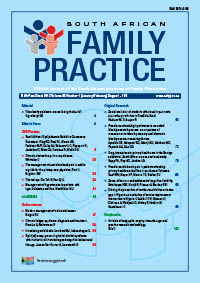Drug interactions in primary health care in the George subdistrict, South Africa: a cross-sectional study
Keywords:
Drug interactions, primary healthcare, prevalence, associations, severity
Abstract
Objectives: To investigate the prevalence of potential drug-drug interactions in primary healthcare clinics in the George subdistrict, to determine which drugs were involved, and to identify associated risk factors. Design: A cross-sectional retrospective folder review was performed. Setting and subjects: Four hundred randomly selected patient files from four primary care clinics in the George subdistrict. Outcome measures: The prevalence of potential drug-drug interactions in primary care, drugs involved in potential drug-drug interactions and associated risk factors. Results: The prevalence of scripts containing at least one moderate potential interaction was 42%; severe potential interaction, 5.25%; and contraindicated combinations, 0.5%. The most common drugs involved were enalapril, aspirin, ibuprofen, furosemide and fluoxetine. The most common implicated drugs in potentially severe interactions were warfarin, aspirin, fluoxetine, tramadol and allopurinol. Two contraindicated combinations were found, namely verapamil plus simvastatin, and hyoscine butyl bromide plus oral potassium chloride. Advancing age and polypharmacy were associated with an increased risk of potential drug-drug interactions. Input from the regional hospital specialist departments greatly increased the risk of a patient being given a prescription that contained a potential drug-drug interaction. Eighty one per cent of severe interactions were from this group. Conclusion: The potential for drug-drug interactions occurring was common in primary healthcare clinics in the George subdistrict. Drug interactions are predictable and preventable. The risk factors identified in this study may assist in the design of interventions that reduce the risk.
Published
2012-08-06
Section
Original Research
By submitting manuscripts to SAFP, authors of original articles are assigning copyright to the South African Academy of Family Physicians. Copyright of review articles are assigned to the Publisher, Medpharm Publications (Pty) Ltd, unless otherwise specified. Authors may use their own work after publication without written permission, provided they acknowledge the original source. Individuals and academic institutions may freely copy and distribute articles published in SAFP for educational and research purposes without obtaining permission.

